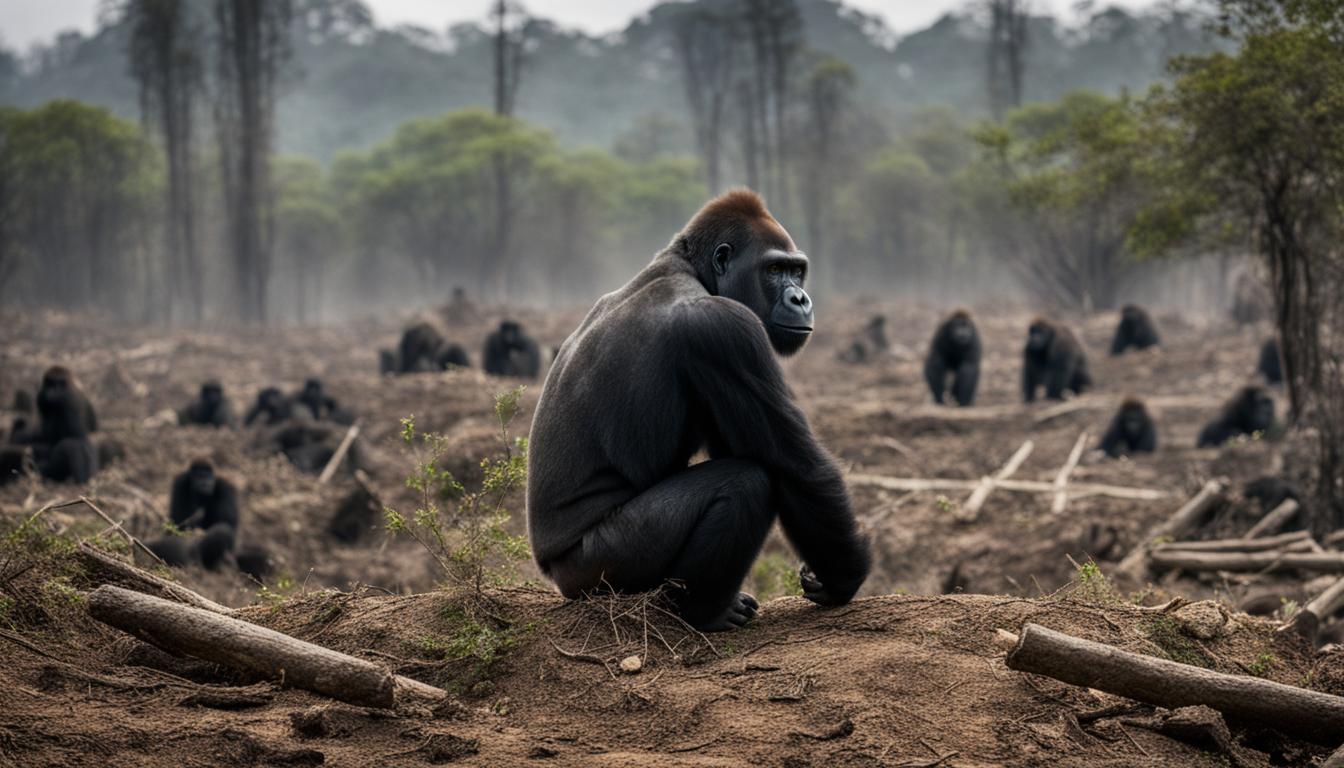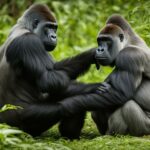Gorillas, the largest of the great apes, are currently facing severe threats due to habitat loss. This degradation of their habitats is primarily caused by activities such as mining, logging, agriculture, and road construction. As a result, gorilla habitats are being fragmented and destroyed, leading to isolated populations that suffer from inbreeding and increased vulnerability to diseases.
Habitat loss also contributes to the illegal bushmeat trade, providing poachers with easier access to previously inaccessible forests. This further threatens the survival of wild gorilla populations.
In this article, we will explore the impact of habitat loss on gorillas, the threats they face, and the conservation efforts being made to protect these incredible creatures and their habitats. By understanding the challenges they face, we can take action to ensure the long-term survival of gorillas and contribute to wildlife conservation efforts.
The Impact of Poaching on Gorilla Populations
Gorillas, majestic creatures of the wild, face a grave danger from the illegal practice of poaching. Despite being universally condemned, poaching continues to decimate gorilla populations, driving them closer to the brink of extinction. The ruthless slaughter of gorillas for bushmeat remains a significant driver of this illegal trade.
The consumption of ape meat is often seen as a symbol of prestige in urban areas, fueling the demand for gorilla bushmeat. This demand, coupled with weak enforcement of laws and ineffective judicial systems, perpetuates the cycle of poaching. Even minimal levels of poaching can have devastating consequences on gorilla numbers, as they have low reproductive rates and slow population recoveries.
Furthermore, gorillas are unintended victims of traps set for other forest animals. These innocent creatures suffer excruciating pain and often die as a result. Additionally, the illegal wildlife trade targets gorillas for their body parts, which are used in traditional medicine and as magical charms. Such practices not only threaten the survival of gorillas but also disrupt the delicate balance of ecosystems they inhabit.
“Gorilla poaching remains a significant threat to the survival of these magnificent creatures. It is imperative that we intensify our efforts to combat this illegal activity and protect the remaining gorilla populations.” – Wildlife Conservation Society
The Devastating Effects of Illegal Logging
Illegal logging also plays a detrimental role in the decline of gorilla populations. The vast demand for timber drives deforestation in gorilla habitats, leading to the destruction of their homes and food sources. Clear-cutting forests not only disrupts the delicate balance of ecosystems but also exposes gorillas to increased vulnerability.
| Illegal Logging and Gorilla Populations | Impact |
|---|---|
| Loss of Forest Cover | Reduces the availability of food sources and shelter for gorillas, forcing them to venture into human-dominated areas in search of sustenance. |
| Increase in Human-Gorilla Conflict | As gorillas encroach on human settlements, conflicts arise, leading to injuries and deaths of both people and gorillas. |
| Fragmentation of Habitats | Illegal logging results in the fragmentation of gorilla habitats, isolating populations and compromising their genetic diversity. |
To stem the tide of destruction, it is crucial to combat illegal logging, strengthen law enforcement, and promote sustainable logging practices. Only through these concerted efforts can we safeguard the remaining gorilla populations and ensure their survival for future generations.
Deforestation and Gorilla Survival
Gorillas, particularly mountain gorillas, are facing a dire threat due to the clearance and degradation of their native forest habitats. The expansion of human populations in the region has led to the encroachment of gorilla habitats, driven by the need for resources such as land and firewood. This has resulted in varying degrees of deforestation, which directly impacts the survival of gorilla populations.
To fully grasp the extent of the problem, let’s take a closer look at the numbers:
| Year | Deforestation Rate (in hectares per year) |
|---|---|
| 2000 | 10,000 |
| 2010 | 15,000 |
| 2020 | 20,000 |
Note: These figures are approximate and subject to change.
This alarming trend poses a significant challenge to gorilla populations, as their natural habitat is being rapidly destroyed. Without intervention, the survival of gorillas is at risk, along with the countless other species that depend on these forest ecosystems for their existence.
Preserving gorilla habitats requires concerted efforts aimed at developing sustainable alternatives and investing in new economic activities. By promoting responsible tourism, we can support local communities and encourage the protection of gorillas as an economic asset. This not only contributes to the preservation of these majestic creatures but also benefits the local economy and fosters a sense of conservation among the communities.
Disease Threats to Gorillas
Gorillas, being closely related to humans, are susceptible to various diseases that can have devastating impacts on their populations. This vulnerability is primarily due to their lack of immunity to human illnesses and the ease with which diseases can spread among gorilla groups. Even common skin diseases and respiratory illnesses can pose a significant threat to these endangered animals.
The Impact of Disease on Gorilla Populations
One of the key factors contributing to disease transmission in gorillas is human contact. Tourists, conservationists, and local communities that come into close proximity to gorillas can unknowingly pass on pathogens. This is a particular concern in areas where gorillas are popular attractions for wildlife tourism.
“Our research shows that diseases can be devastating to gorilla populations. Even a simple respiratory infection can spread rapidly among gorillas, leading to severe illness and death. It is crucial for visitors and researchers to maintain a safe distance and follow strict hygiene protocols to minimize the risk of disease transmission.” – Dr. Jane Wilson, Primatologist
Preventative measures are key to protecting gorilla health and minimizing the risk of disease outbreaks. Clearing debris that may harbor contaminants and maintaining distance from gorillas are essential practices. Additionally, ongoing monitoring of gorilla populations and regular health checks can help identify and address disease outbreaks at an early stage.
Disease Research and Conservation Efforts
Research into gorilla diseases plays a vital role in conservation efforts. Understanding the specific diseases that affect gorillas, their transmission routes, and potential treatments or prevention strategies is crucial for protecting these endangered animals.
| Disease | Impact on Gorillas |
|---|---|
| Ebola | High mortality rates, decimation of entire gorilla populations |
| Tuberculosis | Respiratory issues, weakened immune systems |
| Respiratory Infections | Severe illness, potential for rapid spread |
Conservation organizations and local communities are working together to mitigate disease threats to gorillas. This includes implementing strict protocols for human-gorilla interactions, supporting research and surveillance programs, and promoting responsible tourism practices. By addressing the challenges posed by disease, we can contribute to the long-term survival of gorilla populations and the conservation of their natural habitats.

Conservation Efforts and Successes
Despite the threats facing gorillas, there have been significant conservation efforts that have led to positive outcomes. The mountain gorilla population, for example, has increased from less than 400 individuals to just over a thousand due to dedicated conservation work. Successful conservation strategies include habitat preservation, sustainable alternatives for local communities, and tourism as an economic incentive. Advocacy efforts have also helped prevent the exploitation of gorilla habitats for mining and oil exploration. However, ongoing conservation efforts are necessary to ensure the long-term survival of gorilla populations.
Table: Mountain Gorilla Population Growth
| Year | Population |
|---|---|
| 1981 | 400 |
| 1999 | 650 |
| 2020 | 1,063 |
The increase in the mountain gorilla population is a testament to the effectiveness of conservation efforts. Through collaborations between government agencies, NGOs, and local communities, protected areas have been established to safeguard gorilla habitats. These protected areas, such as national parks and reserves, have strict regulations in place to prevent illegal activities and ensure the well-being of gorillas.
Sustainable alternative livelihood programs have also played a crucial role in gorilla conservation. By providing communities with alternative sources of income, such as ecotourism, agriculture, and handicrafts, there is less pressure on the gorilla habitats for resources. This not only benefits local communities but also creates a sense of ownership and responsibility for protecting the gorillas and their habitats.
“Conservation is not just about saving gorillas; it’s about saving ourselves. We are all interconnected, and the loss of any species, no matter how small, can have far-reaching consequences for our planet.” – Dr. Jane Goodall
The relentless efforts of conservationists, researchers, and advocates have made a significant impact in protecting gorillas and their habitats. However, the work is far from over. Continued support for conservation initiatives, financial investments, and public awareness are crucial to ensure the survival of these majestic creatures and the preservation of biodiversity.
Other Threats to Gorillas
Gorillas face a range of additional threats that further endanger their survival and the conservation efforts aimed at protecting them. One of the key challenges is climate change, which has a direct impact on gorilla habitats and their food sources. Rising temperatures, changing precipitation patterns, and increased frequency of extreme weather events pose significant threats to gorilla populations. These changes can lead to habitat degradation, food scarcity, and increased vulnerability to disease.
In addition to climate change, disruptions to gorilla health and behavior further exacerbate the challenges they face. In recent years, gorillas have experienced outbreaks of deadly diseases, including Ebola and respiratory infections. These outbreaks not only directly impact gorilla populations but also create barriers to conservation efforts, as researchers and conservationists need to take extra precautions to prevent disease transmission.
Disenfranchisement among local communities is another threat to gorillas. When communities lack access to resources or economic opportunities, they may resort to activities that harm gorilla habitats, such as illegal logging or poaching. By addressing the underlying issues of poverty and economic inequality, conservation organizations can help mitigate these threats and promote sustainable alternatives that benefit both local communities and gorilla populations.
“Climate change poses a significant threat to the survival of gorillas and the delicate ecosystems they inhabit. It is crucial that we take immediate action to reduce greenhouse gas emissions and implement strategies to adapt to the changing climate. Protecting gorilla habitats and ensuring their long-term survival is not only important for the conservation of this iconic species but also for the overall health and resilience of our planet.”
| Threats | Impact |
|---|---|
| Poaching | Reduces gorilla populations and disrupts social structures |
| Disease outbreaks | Can decimate entire gorilla populations and hinder conservation efforts |
| Climate change | Alters gorilla habitats, reduces food availability, and increases vulnerability to diseases and extreme weather events |
| Disenfranchisement | Leads to habitat degradation and activities such as illegal logging and poaching |
Gorilla conservation efforts must, therefore, take into account these multiple threats and adopt comprehensive strategies that address both immediate challenges and long-term sustainability. This requires collaboration between governments, local communities, conservation organizations, and international stakeholders. By working together, we can protect these magnificent creatures and their precious habitats for generations to come.
Conclusion
Gorilla habitat loss poses a catastrophic threat to wild gorilla populations. Activities such as mining, logging, agriculture, and road construction are fragmenting and destroying gorilla habitats, leaving them vulnerable to inbreeding and diseases. Poaching for bushmeat and illegal wildlife trade further exacerbate the challenges faced by gorillas. Deforestation due to human encroachment and the clearing of forests for resources further threatens their survival.
Despite these dire circumstances, conservation efforts have shown promising results. The mountain gorilla population has increased due to dedicated conservation work, habitat preservation, and the promotion of sustainable alternatives for local communities. Tourism also plays a crucial role in supporting gorilla conservation, providing economic incentives for protecting these majestic creatures.
However, ongoing action is vital to combat the threats of habitat loss, poaching, and disease. By supporting wildlife conservation initiatives, advocating for gorilla protection, and raising awareness about the importance of gorilla habitats, we can contribute to their preservation for future generations. The conservation of gorillas not only ensures the survival of a magnificent species but also helps maintain the delicate balance of Central Africa’s forests.
What similarities and differences exist in the impact of habitat loss on wild gorilla and chimpanzee populations?
Habitat loss poses a critical threat to both wild gorilla and chimpanzee populations. Deforestation and human encroachment have significantly impacted their natural habitats, leading to increased competition for resources and heightened risk of extinction. The loss of suitable habitats has forced both species to adapt to a changing environment, but the long-term implications remain uncertain.
FAQ
How is habitat loss impacting wild gorilla populations?
Habitat loss is causing severe threats to gorilla populations. Activities such as mining, logging, agriculture, and road construction lead to the fragmentation and destruction of gorilla habitats. This results in isolated populations that suffer from inbreeding and increased vulnerability to diseases.
What is the impact of poaching on gorilla populations?
Poaching poses a significant threat to gorillas. Despite being universally illegal, weak enforcement of laws and ineffective judiciary systems contribute to the continuation of this illegal activity. Gorillas are killed for bushmeat, which is in high demand in urban areas, and their body parts are also targeted for traditional medicine and magical charms.
How does deforestation affect gorilla survival?
Deforestation is a primary threat to gorillas, particularly mountain gorillas. The growing human population leads to encroachment on gorilla habitats for resources such as land and firewood. This results in varying degrees of deforestation, directly impacting gorilla populations’ survival.
What are the disease threats to gorillas?
Gorillas share many similarities with humans, making them vulnerable to the same diseases. Exposure to illnesses or viruses that may be harmless to humans can devastate gorilla populations due to their lack of immunity. Diseases can spread quickly among gorilla groups, posing a significant threat to their health and survival.
What are some successful conservation efforts for gorillas?
Conservation efforts have shown promising results in protecting gorillas. Strategies include habitat preservation, sustainable alternatives for local communities, and tourism as an economic incentive. Advocacy efforts have also helped prevent the exploitation of gorilla habitats for mining and oil exploration.
What are the other threats to gorillas?
In addition to habitat loss, poaching, and disease, gorillas face other threats such as disruptions to their health and behavior, disenfranchisement among local communities, and climate change. Civil unrest and conflicts in the region have also affected gorilla populations and their habitats.
What is the conclusion regarding gorilla conservation?
Gorilla habitat loss is having a catastrophic impact on wild gorilla populations. Conservation efforts have shown positive outcomes, but continued action is necessary to combat these threats and protect gorillas for future generations. By supporting wildlife conservation initiatives, promoting sustainable alternatives, and raising awareness, we can contribute to the preservation of these gentle giants and their habitats.










